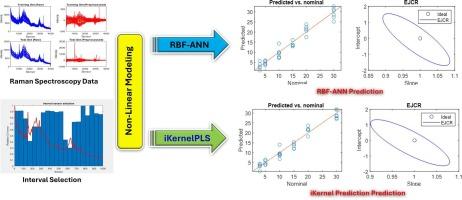利用非线性拉曼光谱模型快速检测乙醇溶液中的甲醇
IF 4.6
2区 化学
Q1 SPECTROSCOPY
Spectrochimica Acta Part A: Molecular and Biomolecular Spectroscopy
Pub Date : 2025-10-04
DOI:10.1016/j.saa.2025.126993
引用次数: 0
摘要
乙醇基产品中的甲醇污染由于其在低浓度下的毒性而构成重大的健康风险。本研究开发了一种快速、无损的方法来检测和定量酒精饮料中的甲醇,使用拉曼光谱结合化学计量模型,包括偏最小二乘(PLS)、区间PLS (iPLS)、核PLS和径向基函数人工神经网络(RBF-ANN)。Kernel PLS模型应用于优化的谱区间,在测试集上实现了最低的相对预测误差(REP%),为6.84%。对添加3 - 20%甲醇的实际样品进行验证,证实该方法在大多数情况下定量甲醇的绝对相对误差低于10%。与气相色谱(GC)和高效液相色谱(HPLC)等传统技术相比,该方法需要最少的样品制备和更短的分析时间,使其适用于食品,制药和化妆品行业的质量控制。本文章由计算机程序翻译,如有差异,请以英文原文为准。

Rapid methanol detection in ethanol solutions via non-linear Raman spectroscopy modeling
Methanol contamination in ethanol-based products poses a significant health risk due to its toxicity at low concentrations. This study developed a rapid, non-destructive method for detecting and quantifying methanol in alcoholic beverages using Raman spectroscopy combined with chemometric models, including Partial Least Squares (PLS), Interval PLS (iPLS), Kernel PLS, and Radial Basis Function Artificial Neural Networks (RBF-ANN). The Kernel PLS model, applied to optimized spectral intervals, achieved the lowest relative prediction error (REP%) of 6.84 % on a test set. Validation on real samples spiked with 3–20 % methanol confirmed the method's ability to quantify methanol with absolute relative errors below 10 % in most cases. Compared to conventional techniques like gas chromatography (GC) and high-performance liquid chromatography (HPLC), this approach requires minimal sample preparation and shorter analysis time, making it suitable for quality control in the food, pharmaceutical, and cosmetic industries.
求助全文
通过发布文献求助,成功后即可免费获取论文全文。
去求助
来源期刊
CiteScore
8.40
自引率
11.40%
发文量
1364
审稿时长
40 days
期刊介绍:
Spectrochimica Acta, Part A: Molecular and Biomolecular Spectroscopy (SAA) is an interdisciplinary journal which spans from basic to applied aspects of optical spectroscopy in chemistry, medicine, biology, and materials science.
The journal publishes original scientific papers that feature high-quality spectroscopic data and analysis. From the broad range of optical spectroscopies, the emphasis is on electronic, vibrational or rotational spectra of molecules, rather than on spectroscopy based on magnetic moments.
Criteria for publication in SAA are novelty, uniqueness, and outstanding quality. Routine applications of spectroscopic techniques and computational methods are not appropriate.
Topics of particular interest of Spectrochimica Acta Part A include, but are not limited to:
Spectroscopy and dynamics of bioanalytical, biomedical, environmental, and atmospheric sciences,
Novel experimental techniques or instrumentation for molecular spectroscopy,
Novel theoretical and computational methods,
Novel applications in photochemistry and photobiology,
Novel interpretational approaches as well as advances in data analysis based on electronic or vibrational spectroscopy.

 求助内容:
求助内容: 应助结果提醒方式:
应助结果提醒方式:


